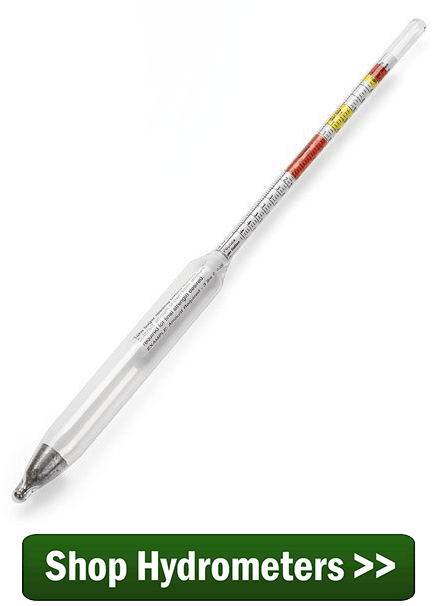 I make wine at home, I do want the wine with more alcohol. But I don’t know how to get this done.
I make wine at home, I do want the wine with more alcohol. But I don’t know how to get this done.
Name: Ketherina D.
State: NY
When it comes to controlling the alcohol level of your wines — regardless of how high or how low — it’s all about the sugar.
Alcohol is made when wine yeast ferments the sugars that are in the wine must. The sugars are converted into both alcohol and carbon dioxide or CO2 gas. (That’s the stuff that makes your soda pop fizzy.) The more sugar the wine yeast has available, the more alcohol it can potentially make.
This concept is all pretty simple up to this point — more sugar, more alcohol — but there are some limits. Wine yeast can only ferment so much alcohol before is slows down and stops completely. Once the alcohol level gets so high, it starts to act as a preservative, inhibiting the fermentation.
Some wine yeast can generally ferment to higher levels of alcohol than others, and vice versa. They are more tolerant of the alcohol, but just as important is the environment that the yeast is thrown into. Things like: temperature, nutrients, oxygen availability, or lack of, all act as variables to the equation of how much alcohol you can end up with with that yeast. It would be safe to say that these variables tend to be more important than the strain of wine yeast you are using.
The reason I’m telling you this is that it is important to understand that when you are trying to drive your alcohol up with more sugar, you can never accurately predict how far the yeast will be able to go. This is a result of all these variables. Usually, you can safely obtain 12% or maybe 13%, but anything beyond this is always in question.
This leads us to your question: how do I make more alcohol? The short answer is, very carefully.
 You can start off your fermentation with enough sugars to ferment your customary 12%. The amount of sugar needed for this can be easily determined by a hydrometer. (see: Hydrometer Scales And What They Mean) But the sugars need to get the alcohol level beyond this need to be feed in a little at a time. This is done towards the end of fermentation.
You can start off your fermentation with enough sugars to ferment your customary 12%. The amount of sugar needed for this can be easily determined by a hydrometer. (see: Hydrometer Scales And What They Mean) But the sugars need to get the alcohol level beyond this need to be feed in a little at a time. This is done towards the end of fermentation.
As you see the original sugars begin to run out, you add a little more sugar. As you see that deplete you add more sugar, again. You keep doing it over and over until the fermentation can go no more. Knowing how much sugar is left in the wine must is something that can be done with a hydrometer, so you will need to make sure you have a handle on its use.
I would suggest taking a look at the article, Making High Alcohol Wines. It goes over this process in greater detail. Another article that may be helpful is How Much Alcohol Do You Really Want. I goes into how alcohol effects the character of a wine. So does the blog post, Keeping Fruit Wines In Fruity Balance.
Happy Winemaking,
Ed Kraus
—–
Ed Kraus is a 3rd generation home brewer/winemaker and has been an owner of E. C. Kraus since 1999. He has been helping individuals make better wine and beer for over 25 years.

How does one make "fortified" wines like sherry?
ok…So when I make wine, the bottom of the bottle is usually murky and I do not bottle that. I set it aside and withdraw the alcohol from it. Then I pour it back into my wine. The pure alcohol from the wine I created gives it a more creative taste because its not store bought. And from the same fruit or grape as is my wine.
Morris, there is no big trick here. It is simply a matter of adding a distilled spirit to the wine before bottling, usually brandy.
After the wine has fermented to the limit of the yeast’s ability, say 16% and then stopped. For sweetening the wine, does it need to be stabilized or is the fact that it has reached 16% ensure that it will not continue to ferment and blow up the bottle or force the cork out?
Dennis, it is still strongly recommended that you add a stabilizer. This is because the yeast that may still be in the wine is now acclimated to the 16% alcohol, so it is only marginally resistant to it. And, keep in mind that a small amount of fermentation can create a lot of pressure!
If you did not achieve the level of alcohol you sought after fermentation, just add pure grain alcohol (PGA) to taste.
I have 6 gallons of blackberry wine nearly ready to bottle. It is not as robust as I want. Can I steam the juice from a gallon of fresh picked blackberries and add this to my wine? I know that will lower the alcohol % if I don’t add straight grain alcohol to bring it back up to 12%. Got any tips?
You can do as you described, but you have to be cautious about adding a pectin haze to the wine. Pectin is the stuff that makes fruit juices look cloudy or opaque. As long as the juice comes out of the steam juicer crystal clear you should be fine. Realize, if you add this juice that you will also be adding new sugar to the wine that’s in the juice. The wine could actually start fermenting again. For this reason you will also need to add potassium sorbate at the same time. This will help to eliminate any chance of re-fermentation. I would also like to point out that a lot of times just sweetening up the wine a little can bring out more fruitiness. You might want to take a look at this blog post for some more insight: https://blog.eckraus.com/keeping-fruit-wines-in-fruity-balance
I’m looking for a conservative conversion factor for gallons of “must” to net gallons in the barrel after fermentation.
If I crush a volume at harvest equal to 100 gallons, what will my net gallons be after we press?
And I realize it depends on how hard we press that makes a difference.
You are right, it does vary from grape to grape and harvest to harvest. A good rule of thumb I have found is 72%. At your 100 gallons, look to net about 72 gallons. Another rule of thumb I use is 13 pounds of grapes to a gallon of finished wine. Of course, this varies too.
I routinely get 18%- 20% ABV. I used to use Premiere Cuvee yeast to achieve this, but they changed it. Now I use EC1118 to get the high ABV. I usually have a starting specific gravity of 1.140. Good stuff !!